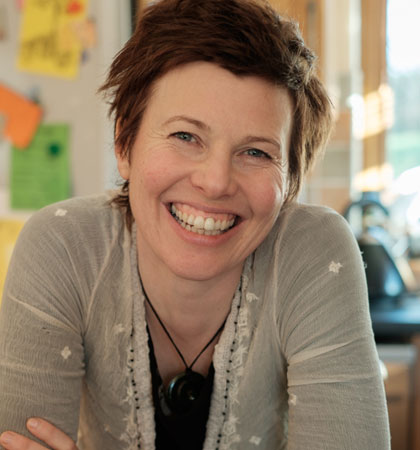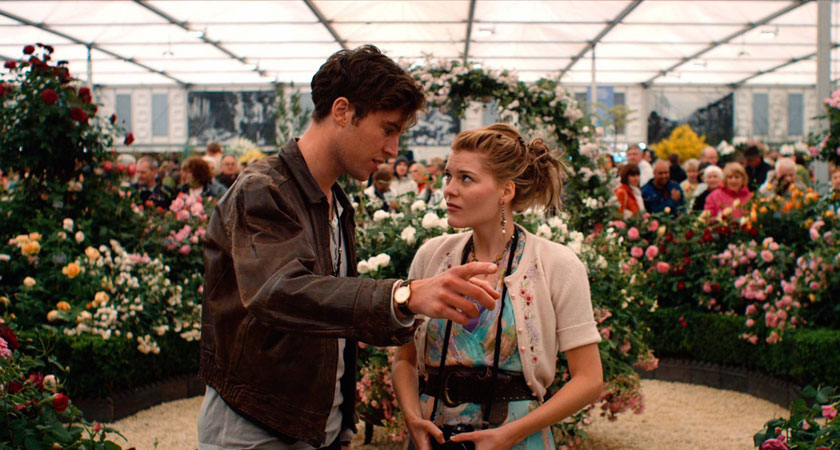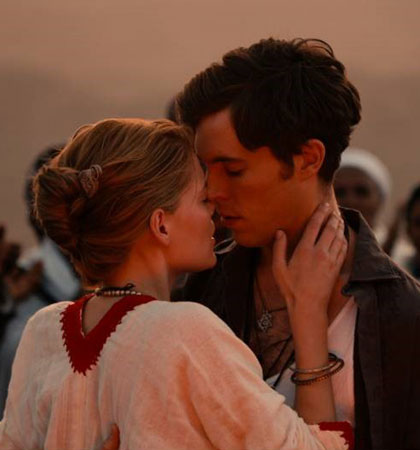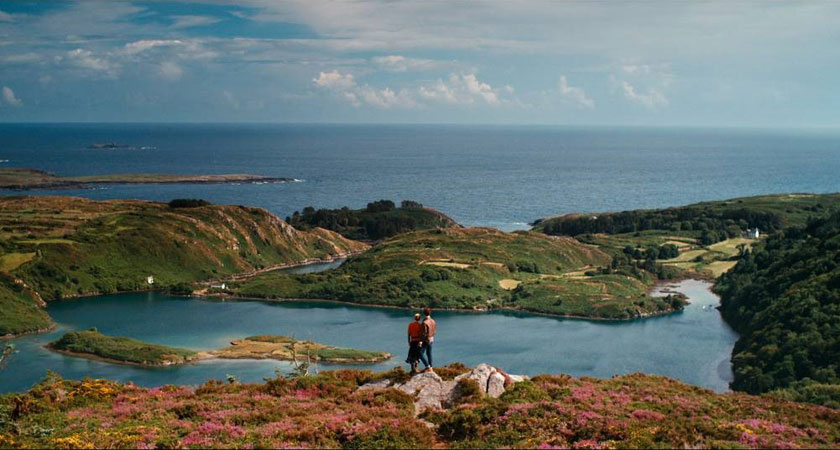VIVIENNE de COURCY discovered her love of the outdoors and the unspoilt landscape of the Irish countryside when, as a young girl, her father would take her on nature study walks on the shores of Ireland's Lough Ree in search of rare flowers.
"We were always looking for the bee orchid," she says recalling how aged 10, and after a four-year long search, they finally found the eye-catching bloom.
"He would have a book on fossils in one pocket and a book on wild flowers in the other and I remember him being so excited," she says.
"The day we found the bee orchid was a very, very exciting day. He loved being in nature."
That call to the wild continued to blossom for de Courcy in her adult years, no more so than when she found herself living in the concrete surrounds of a Chicago high-rise where she was working as a corporate lawyer.
"I used to go back to Ireland, I'd get 10 days and I'd head for West Cork," she says. "Living in Chicago, all I wanted to do was get back to Ireland."
While navigating the corporate waters and building her law career in the States, de Courcy's real dream was to build something altogether more earthy in her homeland.
Faced with the daily grind of urban life, she channelled her passion into a hobby, writing scripts and science fiction tales about the world's fragile eco-system and the risks it faces unless society changes its environmentally destructive ways.
"Mary Reynolds and I talk about this all the time and wonder why do people not realise what's happening," she says. "It's like Trump or Brexit, you can't make the exact calculation of what's going to happen but it's not going to be good."
Her ominous scripts feature stories of oxygen-starved cities, collapse and contamination and a planet where nature has all but been destroyed.
Fast forward to 2000 and the opportunity arose for de Courcy to finally move back to Ireland where she bought a picturesque coastal hill farm in West Cork knowing her garden would have to be an antidote to the doomsday future her imagination had conceived.
"I love the lyrical, lush, wild, West Cork coast vegetation and I thought if I could just one day get a little piece of that," she says.
Having finally found her dream home, she then set about creating a wish list for her wild garden to hug the walls and soften the acre of land on which it sat.
"I wanted a fairy tale glade and the theme to be Celtic zen," she adds, describing how her desire was to have wild flowers and plants intertwine mystically with age-old hawthorn trees.
By now it was 2004, the year that would prove the serendipitous moment for her introduction to Mary Reynolds who, just two years earlier, had become the youngest winner of a Gold Medal at the Chelsea Flower Show – the iconic British horticultural feast attended by hundreds of thousands of green-fingered enthusiasts each year.
"I wrote a 10-point design brief for a wild garden. The idea was to have no right angles, have a moated effect to reflect the light off the water – to have a fairy tale effect," she says.
But efforts to find a designer who could interpret her vision proved harder than she'd anticipated.
"They'd obviously used my brief as toilet paper," she jokes recalling the off-the-mark plans she received back in those early days.
"It was everything I didn't want. Then someone said you want that girl who won the Chelsea Flower Show.
 Mary Reynolds, who won the Gold Medal against the odds at the 2002 Chelsea Flower Show [Image: Conor Horgan]
Mary Reynolds, who won the Gold Medal against the odds at the 2002 Chelsea Flower Show [Image: Conor Horgan]"Then one day, a month later, Mary Reynolds turned up wearing big boots, a full-length green tulle skirt that was dragging along behind her in the dirt, with a building site helmet and a lot of attitude.
"She thought I was some kind of banker yuppie, which is probably what I looked like then, but I was playing the part, it really wasn't me.
"Once she realised I wasn't a yuppie at all, except technically, I kind of got accepted. It was a very different world then, the Celtic Tiger was roaring, people were doing mad stuff, I was terrified by that."
De Courcy remembers the day Reynolds' design literally dropped on her doormat.
"About six months later this thing arrived in the post and I thought, this is extraordinary and now I have the build it, where am I going to get the money?" she laughs.
"When Mary built the garden and then told me her story, it fitted exactly in with those science fiction epics. I feel those characters are going to be the great-great-grandchildren of Mary Reynolds."
With both women sharing similar philosophies of how we should live and care for our natural habitat, they struck up a friendship that has continued today and culminated in de Courcy's new film Dare to be Wild – the story of Reynolds' Chelsea win.
"If we can invite wild nature into the space we control ourselves, into our own gardens, then people as a whole will begin to know the difference," the environmentalist says.
"Try a clover lawn and the garden's alive, you've got butterflies and everything, birds taking the seeds… that's what we want to change. As Mary says it's about becoming a guardian of the wild. It's how you support the dynamism of wild nature rather than how you kill it off.
"It's about our children and our grandchildren and somebody has to start doing this. And it's good to do it through an accessible movie."
De Courcy has also launched the Dare to be Wild Movement, which she hopes will encourage people to think and act to save their environment.
She unequivocally believes it's time to stop destroying wildlife and nature and start preserving our hedgerows and pastures.
"They're obsessed with cutting in Ireland," de Courcy says with dismay, citing as just one example how the country's hawthorn hedges are being ruined.
"I've been telling farmers they're the fairy trees of Ireland and I've seen a few more standing this year," she jokes before taking on a more serious tone.
"People are getting more and more detached from the land. You walk around gardens and they are beautiful but as Mary Reynolds says they are beautiful in the way a made-up girl's face is beautiful – it's not glowing with light force and natural energy.
"Any garden no matter how small it is can support one tree," she adds, referring to the same concept of forest gardening that forms the basis of Mary Reynolds' new book The Garden Awakening.
 Christy Collard, played by Tom Hughes, and Mary Reynolds, played by Emma Greenwell, in Dare to be Wild
Christy Collard, played by Tom Hughes, and Mary Reynolds, played by Emma Greenwell, in Dare to be WildDe Courcy hopes her film, which she both directed and wrote the screenplay for, will inspire those who see it to become more nature-conscious.
'People travel the world over to visit untouched places of natural beauty, yet modern gardens pay little heed to the simplicity and beauty of these environments, those special places we must preserve and protect, each in his own way before they are lost forever.'
This is what Mary Reynolds wrote in her Chelsea Competition application in 2002.
She's previously described winning the prestigious award as a mixture of 'luck and balls', which is a fair assessment.
While most competitors have one sponsor who will pay upwards of £250,000 to built their designs, Reynolds was backed by 14 individual donors and had to enlist help and favours from family and friends to transport her garden – featuring a sheep field, 500 wild plant species, 200-year-old hawthorns and tonnes of ancient wall from Cork – to the English capital.
With just weeks to build her vision, she and her team of 16 slept in a three-bed flat in London's Marble Arch where they would build at Chelsea by day and collapse into sleeping bags at night.
Described as an against-all-odds romantic adventure, Dare to be Wild takes you from the Irish hills to the deserts of Africa and then to London's Chelsea where Mary, played by Shameless US actress Emma Greenwell, is on a quest to show the world the power of wild nature through her Celtic Sanctuary design – a mystical wild garden that promotes the preservation of natural habitats.
Not to spoil the plot with the hows and whys, her garden is later chosen as one of only eight to compete at Chelsea that year out of over 2,000 applications worldwide.
Having grown up on her family's organic farm in Wexford, the film plots Reynolds' journey from naïve country girl to a pioneering landscape designer.
Having studied landscape horticulture at University College Dublin and after becoming Ireland's first ever winner at Chelsea, the mum-of-two also went on to become the first designer in 250 years – since 18th century landscape architect Capability Brown – to have her own wild garden build at London's Royal Kew Gardens.
Her romance with the eco-designer Christy Collard – played by Tom Hughes, who is currently starring as Prince Albert in ITV's Victoria – is also central to the film's storyline.
It sees her journey to Ethiopia, where Collard was building a forest park, to convince him to help her build her Celtic Sanctuary – an untested wild design that eventually wins over the hearts of the establishment at the Chelsea Flower Show.
Reynolds' unconventional win was just one of three Gold Medals awarded out of 19 entries in the Show Garden section in 2002.
Taking inspiration from Wicklow (where she was living at the time), Co. Meath's Hill of Tara and Celtic mythology, its huge stone thrones and mature hawthorns captured the public's and the judges' attention – not to mention a certain Prince Charles, who took the Silver Medal that year.
"People from Ireland would say it was like a little piece of home," Reynolds said recently when recalling the reaction her garden received at Chelsea.
"Everybody remembers it," de Courcy adds.
And now thanks to her film a whole new audience will have the chance to rediscover this charming story that reminds us just how precious and worth protecting nature is.
Dare to be Wild is now available to watch on Netflix in North America



